Ultra - a profitable short rotation regime for radiata pine on high quality sites
Graham West, New Zealand Tree Grower May 2018.
A new management regime is proposed for growing radiata pine for export logs on a short rotation. The ultra regime is to plant 500 stems a hectare using best quality genetic stock on good sites and to not prune or thin. It is very simple to follow and could cash in on an expected wood flow shortfall in 16 years.
Predicted returns are good, giving an expected nett stumpage of $20,000 a hectare after 16 years, equivalent to a land expectation value of $5,300 a hectare or $430 a hectare each year. With carbon sales added to the cashflow, the rate of return excluding land costs is just under 18 per cent. Who could afford to miss out on this financial opportunity? Even at my age I am tempted.
Wood supply forecasts
Plantation forestry in New Zealand has a major opportunity in the next few years to make a significant contribution to New Zealand’s wealth and wellbeing by addressing many of our environmental challenges and boosting regional economic growth. The farming sector faces limits and restrictions from public expectations on water quality, greenhouse gas emissions and soil erosion. Forestry also faces problems of negative land owner sentiment and wood supply fluctuations.
Most regions in New Zealand have a wood supply forecast which shows a very large wave of around six to eight million cubic metres a year flowing through. This will provide rapid increases in the next six years with a rapid reduction after approximately 16 years. The graphs below from the Ministry for Primary Industries 2014-15 Wood Availability Forecast are typical of at least eight regions. The large-scale forest owners shown in blue have a long-term cut plan primarily to give a non-decling yield. The small-scale owners shown in green have been assumed to cut their trees at age 28 years.
It is reasonably uncertain when small-scale growers will harvest because it often depends on log price and many personal and financial circumstances. But it is very likely that the peak flow indicated in the graphs will be significantly flattened because of the limited availability of harvesting contractors and trucks, along with limits in market demand.
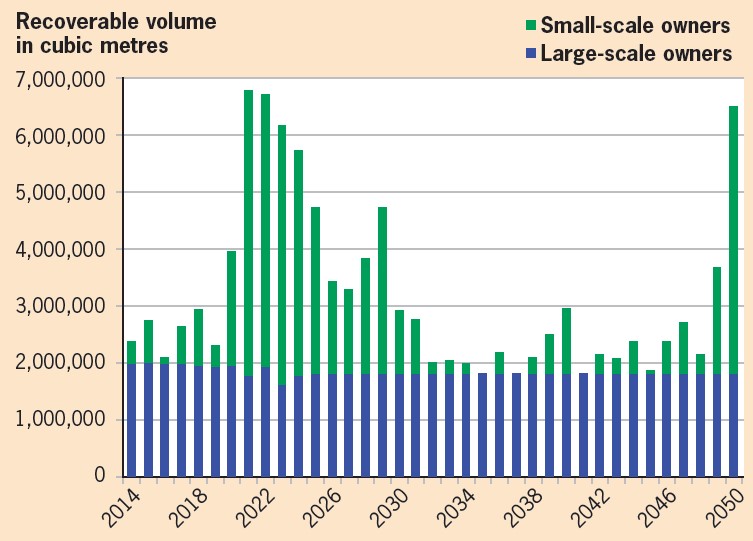
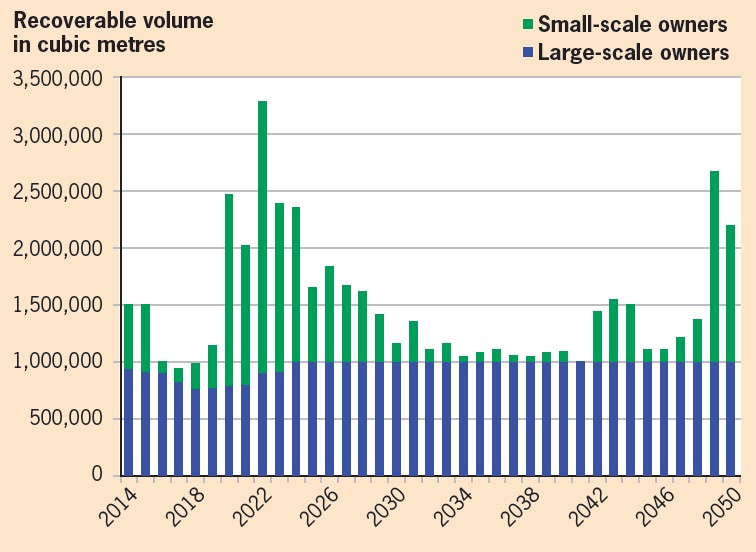
Currently, while log prices are good, many woodlots are being felled at age 24 to 25 and not 28 which flattens the curve forward or to the left. The problem with this wave of opportunity is the trough behind it. In 15 to 17 years’ time, there will be a reduction of 1.5 to 2 million cubic metres a year in some regions. This will result in approximately 15 harvesting gangs being redundant in each region along with about 60 truck drivers not needed, with consequences to service and support staff. Importantly, it creates uncertainty for potential wood processing investors and as a result this wave of opportunity only gets exported as logs without creating maximum jobs and added value.
New forest planting rates have been low for the last 10 years with 100,000 hectares of deforestation. While log prices have been good for the last five years there has still been a reluctance by land owners and fund managers to invest in forestry. Land prices have risen considerably, but for existing farmers, iwi and joint venture partners, land costs are not really the problem. Part of the problem is the long investment period, a lack of land owner knowledge on forestry, and the uncertainty around government policy and carbon trading regulations.
Short rotation option
To solve the above problems, a change in thinking is needed and some outrageous challenges made to traditional forest management. What could be done is a very short rotation to provide increased wood flow in approximately 16 years, a significant increase in profitability without carbon and a considerable effort in forest extension, particularly forest economics and business structures, to get land owner and investor interest.
Based on my experience in forestry science and practical knowledge in farming and forestry, this study suggests the following radical regime. If we used the best available genetics in our tree stocks in terms of growth rate and wood quality on fertile sites, and planted them at low stocking rates to avoid thinning, did not prune to minimise cash inputs, and clear felled at age 16, what would the economics and log grades be like? These are not really ultra-radical suggestions. The idea of short rotation has been tossed around by many innovative foresters such as Neil Barr, Harry Bunn, Wink Sutton and Leith Knowles. Perhaps it is just the right time for it.
Modelling
To examine this I have used a modelling method and the Radiata Pine Calculator v4.0 which is a farm foresters’ tool, so that others can repeat the exercise for themselves. To keep this brief, I have examined only four concerns −
- What is a reasonable rotation length for a low-cost plant and leave a regime of 500 stems a hectare?
- If we prune to six metres and waste thin at age eight to none, what would be the best final crop stocking for 16-year rotation length?
- If we do not prune and waste thin at age eight to nine, what is the best final crop stocking for 16-year rotation length?
- What affect does discount rate have on the best rotation age?
This does not intend to cover the complete matrix of possible questions which arise with this sort of regime evaluation exercise, simply to examine the broad feasibility of a regime that could spark interest in a new wave of afforestation. I have given it the code named ‘ultra’. I am sure you will remember where this was last was used.
The regime is intended for high quality sites only, with Site Index above 30 metres and 300 Index above 29 cubic metres a hectare each year. This is needed to produce marketable log sizes by age 16 and to have adequate wood density provided by warmer more productive sites. Good height growth is important because it helps control branch size with earlier shading of lower branches.
The tree stock genetic quality, such as GF Plus rating, needs to be at the upper limit for wood density, low spiral grain, straightness and growth rate. Juvenile cuttings should be used to provide early stability and natural good form − stem straightness and branch size. To cover this I have allowed $2.50 for establishment costs per tree which includes land preparation, tree stocks, transport and chemicals for releasing. It also assumes easy establishment and survival on pastoral sites or clean cutover.
Location, location, location
The following are the details for the silvicultural regime. Plant 500 stems a hectare and clear fell at age 16. That is it. There is nothing else to remember except using the best genetics on the best sites. Three other things matter, location, location and location because this determines roading, harvesting and transport costs, but that is for another time.
For the economic analysis I have assumed the following for rotation at age 16 unless otherwise stated −
| Site Index | 33 metres boosted by genetic gain |
| 300 Index | 29 cubic metres a hectare a year |
| Plant | 500 stems a hectare |
| Survival | 95 per cent |
| Altitude | Up to 350 metres |
| Latitude | 38 degrees |
| Pruning | None |
| Thinning | None |
| Clear fell yield | 85 per cent of total volume |
Costs, prices and returns
Annual fixed costs such as rates, insurance and management would be $65 a hectare each year. Roading would be three dollars a tonne, log and load $35 a tonne and log transport $20 a tonne to give a total cost of $58 a cubic metre. Log prices are based on being delivered to port and based on the Ministry for Primary Industries 12 quarter average for pruned trees and adjusted down for age.
| Grade | Price |
|---|---|
| Pruned | $166 a cubic metre |
| A grade | $119 a cubic metre |
| K grade | $113 a cubic metre |
| KS grade | $75 a cubic metre |
| Pulp | $50 a cubic metre |
The total merchantable volume for the ultra regime at age 16 for this site quality is predicted to be around 500 cubic metres a hectare. Log grade volumes are in the table below.
| Log grade | Code | Volume in cubic metres per hectare |
|---|---|---|
| A grade - long, 12.1 metres | AL | 0 |
| A grade - medium, 8.1 metres | AM | 7 |
| K grade - Long, 11.1 metres | KL | 337 |
| K grade - medium, 7.3 metres | KM | 9 |
| K grade - short, 5.5 metres | KS | 84 |
| Pulp − 5.5 metres | Pulp | 62 |
| Total merchantable | 499 | |
| Waste | 88 |
To examine how this grade mix may change, the rotation age was extended and is shown in the graph below. This shows what happens if the stand had to be grown on to an older age, perhaps if prices were low at age 16, or the cash was not needed.
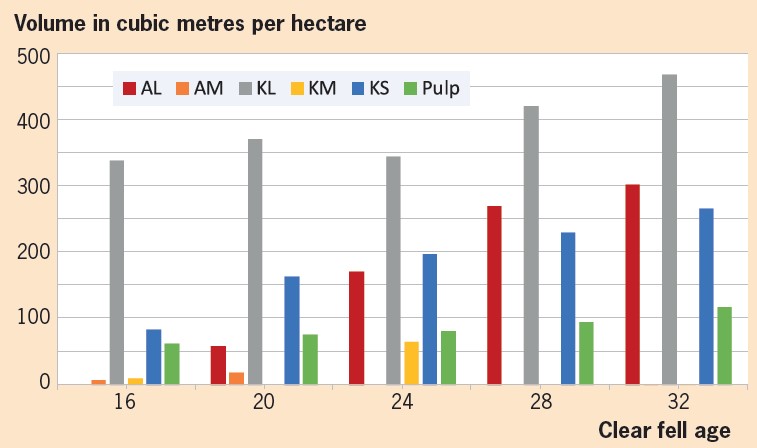
This shows increasing volumes with time, particularly the KL, A, and KS grades. If the export market was not an option at harvest age, the next graph shows the grade mix with clear fell age for domestic grades. It shows that L grade logs would predominate. These are logs with the largest branch diameter in the 6 cm to 12 cm range.
The grade is typical of what the export market consumes and may not easily be sold domestically. Wood volumes given above are in cubic metres per hectare. If the current conversion to JAS still exists in 16 years, the volume of export grades will reduce significantly.
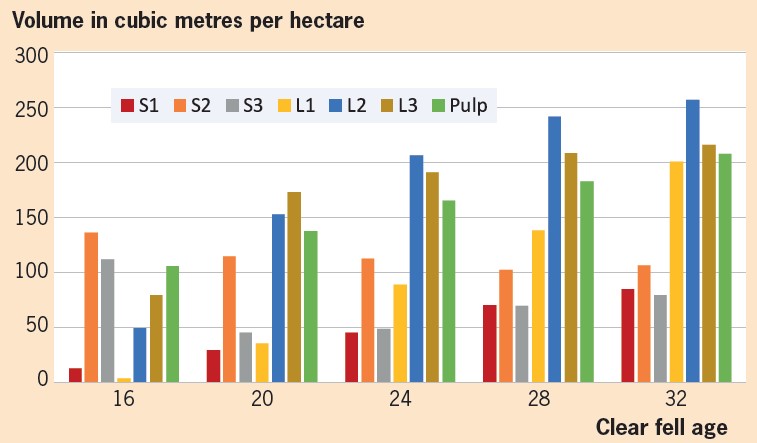
Stumpage returns nett to the grower for the 16-year rotation with the costs and export prices assumed are $20,425 a hectare. This is not as much as current full rotation returns but you receive it about 10 years earlier. Using discounted cash flow, all built into the Radiata Pine Calculator, at eight per cent a year, the analysis adjusts the returns for the period of investment and calculates a nett present value of $3,800 a hectare which converts to a land expectation value of $5,370 a hectare. A land expectation value is more useful because it is the price you could pay for the land and earn eight per cent return from the land production in perpetuity.
Put another way, if the land costs $5,370 a hectare, this regime makes eight per cent internal rate of return. If the land costs a lot more you make a much lower rate of return. These figures are better converted into the equivalent of an annual payment, such as an annuity, and works out to be $430 a hectare each year. This is about the same as good sheep and beef finishing returns, although the forestry would presumably be on poorer land.
Converted to the equivalent of a farm gross margin per livestock stock unit it is around $82 per livestock stock unit at a carrying capacity of six stock units a hectare. However, if the logs were all sold domestically, the nett returns would drop to about $14,000 a hectare.
This may change if new engineered wood processing, biofuels for transport and biomaterial engineered products are successful in 16 years.
To examine the optimum rotation length for this regime, the Radiata Pine Calculator was run for rotation ages 14 to 34 years. Results are given in the next graph.
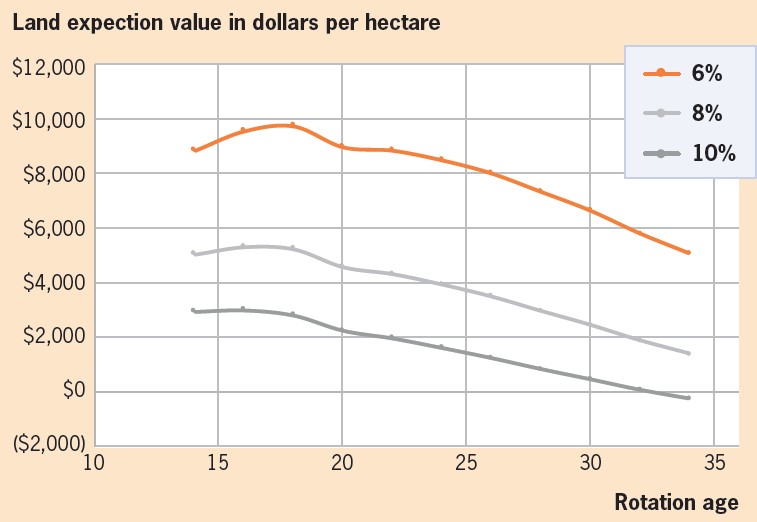
Land expectation value was found to peak at around 16 years for the costs and prices assumed. A main consideration here is whether the log market develops a better premium for older and larger diameter logs. The K grade logs currently consumed by the export market are mostly from the upper sections of the current older trees, and are likely to have the same number of rings and similar wood properties to ultra logs. KS logs, also known as KIS, are predominantly core wood, similar to pulp grade and currently traded at prices higher than I have assumed. This is mainly because if there is any downturn in the Chinese market, demand for this grade can disappear.
Discount rate or time preference for cash has a large effect on the land expectation value. If a rate of six per cent was acceptable then land prices around $9,000 a hectare could be paid.
Regime variations
To examine if the regime could be improved with different silvicultural options, variations in the number of stems planted with and without thinning was tested. It was also checked to see if pruning to 6.2 metres could help improve profitability The graph on the right gives results for a range of regimes in terms of land expectation value at eight per cent discount rate.
Pruning gave no improvement over such a short rotation age. It was not sensitive to final crop stocking for the pruned log prices assumed, with land expectation values around $3,000 below the ultra regime marked with an arrow on the graph. Adding a thinning to waste process at eight to nine years was also well below the ultra regime. It would improve the look of the stand, and probably produce logs of better grade than was modelled, but would require a higher planted stocking to be worthwhile, adding cost, complexity and effort.
The planted stocking for the ultra regime was also close to final stocking of 400 to 600 stems a hectare and therefore not tested with a thinning. This appears to be a trade-off between establishment costs and improved merchantable volume, especially for the high costs expected to be paid for the high quality genetically improved stock. At $4.50 instead of $2.50 for every established tree in the plant and leave regime, this relationship tilts down at the higher stocking end indicating a lower stocking around 450 stems a hectare could be better if costs rise. However, there is a need for practical over-ride and although I have planted a commercial stand at 400 stems a hectare, there is little room for things to go wrong.
Carbon
There is the opportunity with this regime to join the Emissions Trading Scheme and sell carbon units. Assuming carbon sequestration occurs at the conservative rate as in the Ministry for Primary Industries look-up tables for less than 100 hectares, and only the safe carbon is sold every three years at a carbon price of $21 a tonne, economic returns begin to improve considerably.
The nett present value increases by $929 a hectare, land expectation value increases by $1,313 a hectare and the annuity increases by $105 a hectare. The internal rate of return excluding land costs increases from 15.8 per cent to is 17.8 per cent.
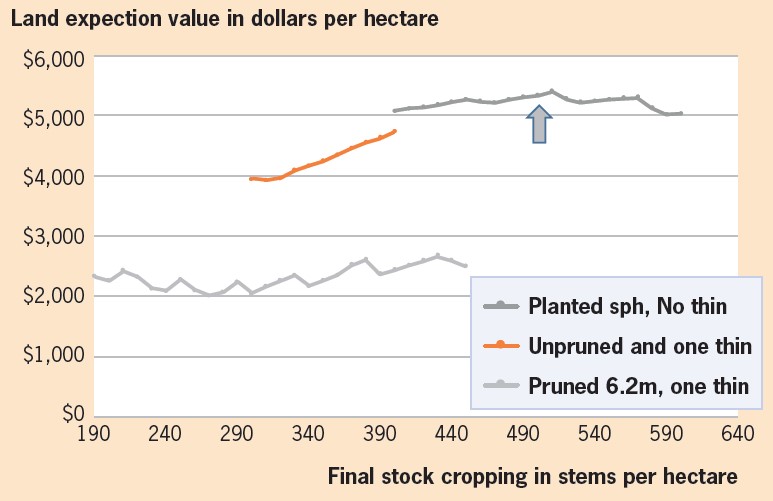
Discussion
This regime evaluation depends on the modelling system replicating the real world. The Radiata Pine Calculator has been tested by Scion and used by many foresters, but these results should be critically evaluated with a small amount of scepticism and conservatism, or whatever you find is prudent. However, this result is underpinned by the technology and knowledge which has been accumulating for some time in the science programmes and industry trials.
It is also showing up in the increased realised volumes at harvesting with improved tree breeds planted on farms in the 1990s. In my own farm forestry joint venture, in 1990 we planted 400 stems a hectare GF22 juvenile cuttings and never thinned. With the next block we lost our nerve a bit and planted 500 stems a hectare with GF 25 juvenile cuttings and hoped to production thin, but this never happened. The stands were all pruned to six metres based on 350 stems a hectare and are looking excellent. They have been pre-harvest inventoried and about to be felled. While this is on a dry Hawkes Bay site with 650 mm annual rainfall, the tree form is very good and most visitors to this forest cannot believe it has never been thinned.
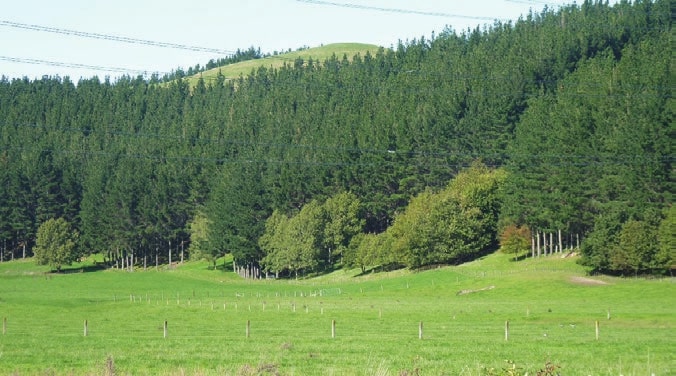
An opportunity
Radiata pine responds to fertile sites, moderate rainfall and low stocking by growing at an astonishing rate and its improved carrying capacity with better genetics has led to a trend of higher final crop stocking. This is not inconsistent with what has been found here.
What is important is the reduction in supply in 16 years. This may offer small-scale growers a good opportunity to cash in earlier if their life circumstances suit that option. In addition, the rapidly developing science of biomaterials means a greater demand for wood fbre, it is unlikely that wood will still be used in traditional forms or sold to the same markets. Afforestation grants from government or local authorities will only enhance the economic opportunity outlined here.
The concept of this regime could be tested with other species, particularly eucalypts and poplars. The market risk with these species is possibly greater, but a preference for non-pine species is common and may better suit your aesthetic preference.
For farmers and urban professional investors, the practice of growing a commercial forest has to be simple and quick. They are not so enamoured by the nuances of fine tuning the silviculture or the beauty of a well grown stand of fat straight butt logs. Land is about lifestyle and cash is king. I hope this has revitalised your interest to plant trees and to take advantage of the opportunity the ultra regime offers.

 Farm Forestry New Zealand
Farm Forestry New Zealand